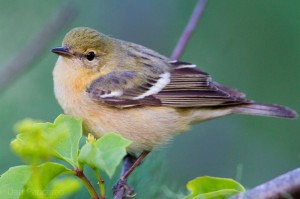At last! I finally had a birding outing planned last Saturday – the first one since April when I helped lead a trip for the Wildflower Pilgrimage. But, the primary guiding force of my life happens to be Murphy’s Law.
My friend Bob Olthoff made it to my house a 6:30 a.m. sharp and we struck out for Ridge Junction Overlook on the Blue Ridge Parkway at the entrance to Mt. Mitchell State Park. Ridge Junction is a unique fall migrant trap where you can just hang at the overlook and migrants come up the valley from Mt. Mitchell and many stop momentarily at the Parkway. But about a mile or two past the Folk Art Center we encountered a huge oak, Mr. Murphy had placed across the BRP.
Okay, Ridge Junction was out of the picture, but what the heck we were on the Parkway and it was still early so we decided to drive the Parkway back south to Waynesville and see what we could find. The one thing easy to find – and lots of it – was fog.
Heavy fog, overcast skies and blowing clouds are not ideal conditions for migration. And birds were, for the most part still and quite. But even when birds are hard to come by, there’s something to be said for being out on the Parkway. Maybe it’s the juxtaposition of sliding out deep fog as you round a curve to find yourself looking at blue sky with green mountain peaks protruding through a blanket of dingy white only to be swallowed by the fog again around the next curve.
Or, maybe it’s screeching to a stop around one of those curves to check out a silhouette on top of a dead snag and being rewarded with an olive-sided flycatcher. Or getting great up-close views of your FOS (first of the season) fall-plumaged bay-breasted warbler, or perhaps the silent, foggy flyby of a Cooper’s hawk. Not to mention the stands of flowering grass-of-Parnassus along with gentian and turtle’s head on the large seepage area at Wolf Mountain Overlook. Oh, and don’t forget the butterflies – American lady, great spangled fritillary, buckeye and others.
Murphy’s Law – 0 Don & Bob – 1
Head State Park – Probably the most prolific raptor migration spot in the region, averaging about 12,000 broad-winged hawks a season: Caesar’s Head State Park on US 276, in South Carolina just below the North Carolina.
- Ridge Junction Overlook – On the Blue Ridge Parkway at milepost 355 next to the entrance to Mt. Mitchell State Park.
- Jackson Park – Another great spot for migrating songbirds: From Waynesville take Exit 49 B off of I-26 East. Continue on U.S. 64 West towards downtown Hendersonville; go through the traffic light at end of exit ramp onto Four Seasons Boulevard (U.S. 64) for 1.6 miles (passing 4 more traffic lights). After a wetland area on the left, turn left at the 5th traffic light (Harris Street). Go 0.2 mile to STOP sign at end of street. Turn left onto E. 4th Avenue, enter park and follow road to Administration Building (red-brick house on left) and parking.
- Rankin Bottoms Wildlife Management Area and adjoining Dutch Bottoms. Ranking Bottoms and Dutch Bottoms produce many species of migrant shorebirds and waterfowl every year including white pelican, tundra swan, upland, white-rumped, pectoral, least and solitary sandpiper, greater and lesser yellowlegs, ruddy turnstone, black tern and more. Rankin Bottoms lies along the confluence of the Nolichucky and French Broad rivers about two miles from the mouth of the French Broad. TVA’s Douglas Dam regulates the water level at Rankin Bottoms. Much of the bottoms are accessible by vehicle and by foot during the fall and winter when TVA drops the water levels: From Waynesville, take I-40 west to exit 432 B. That will put you on Hwy. 25/70. Follow Hwy 25 East out of Newport to Rankin Hill Road. (I would estimate about 5 miles, but I have never measured it). There will be a brown “Watchable Wildlife” sign at Rankin Hill Road. Follow Rankin Hill Road to the railroad crossing.

